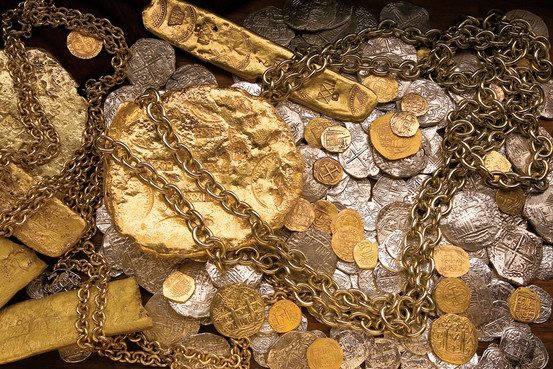The Caribbean, the real treasure trove of the sunken Spanish Silver Fleet, leads in the number of treasures found and not found. Meanwhile, not only in the Caribbean it is worth looking for gold, silver and ancient treasures, because the richest sunken treasures found not only there.
Nuestra senora de las mercedes
In 2007, in the waters of the Gibraltar Strait near Portugal, a huge treasure was found on a sunken Spanish military frigate. The American company “Odyssey Marine Exploration” raised 500 thousand silver and gold coins, as well as jewelry and jewelry, from its side. However, the company did not announce the ship’s ownership for a long time, and then the information was made public when gold and silver were already shipped to the United States.

Several years of investigation and litigation – and it turned out that the treasures were discovered at the site of the flooding of the Spanish warship Nuestra Senora de las Mercedes, which was attacked by English ships in October 1804 on the way to Spain from Peru and went to the bottom off the coast of Portugal.
In December 2009, a Florida state court ruled that the sea treasure belongs to Spain, and even appeals against the court’s decision left it unchanged, so that all the wealth found in the amount of $ 500 million was transferred to the Spanish government as historical value.
Blue baron
In 2009, in the Atlantic, off the coast of Guyana, a huge treasure worth more than $ 3 billion was discovered. However, these are quite “recent” treasures: during World War II, a ship sank in these places, the holds of which were full of gold, platinum and diamonds.

It was not possible to classify the information about the treasure completely (even the name of the vessel is conditional: Blue Baron), so today there are two versions of its origin: according to the first, the owners of the cargo were the Soviet Union and Great Britain, and according to another version – only Soviet Russia, which paid thus with allies for food, weapons, and clothing. In 1942, the ship was torpedoed and sunk by a German submarine.
Nuestra senora de atocha
An American archaeologist and treasure seeker, Mel Fisher, has been trying for 15 years to find a Spanish galleon that sank off the coast of Florida in 1622. Sailing ship transported ingots, coins, unique jewelry and precious stones. It was only in 1985 that luck smiled at the seeker: Nuestra Senora De Atocha was found.

From the bottom of the sea, 3.2 thousand emeralds, 150 thousand silver coins, more than one thousand silver bars, 200 gold bars and many jewelry were raised. The cost of the treasure amounted to 450 million dollars, but that’s not all, because at the bottom there are still treasures worth more than 500 million dollars.
Nuestra Señora de la Concepción
The story of the Concepcion ship is similar to the fate of the Atocha – it was also a Spanish galleon carrying goods from the colonies. In 1641, the ship left Cuba, loaded with so many treasures that they had to be placed on the upper decks. The ship was not designed for such weight, lost its course and did not obey the helm. Once in a storm, the ship got stuck in coral reefs and sank off the coast of Haiti.

Almost 200 people survived, including the admiral, thanks to which the exact place of the shipwreck was established. Already in 1682, the treasure hunter William Phipps with the Indians. searching for pearls, he lifted 28 tons of gold from the bottom. But according to experts, this is only a tenth of what was at Concepcion.
Whydah
In 1717, Whydah, a pirate galley, ran aground, just a few hundred meters from the Florida Cape Cod Beach in Marconi Beach. There were legends about the wealth of the galley, because before the death of the ship, the pirates managed to rob about 50 other ships.

The marine archaeologist Barry Clifford studied ship documents for several years, as a result of which he estimated the treasure at the gallery at $ 400 million – according to the most conservative estimates, the gallery contained at least 4.5 tons of gold sand. Clifford found the remains of the galley in 1984 and managed to raise about $ 15 million from the bottom of the sea treasures.
Of course, this is far from all the treasures found and valued by modern standards. Spanish galleons in the Caribbean, for example, will be enough for a couple of thousand treasure hunters, and researchers even draw up special maps with the approximate location of the remains of the ships. According to the most conservative estimates, about 600 more treasures not found at the bottom of the sea remain.





